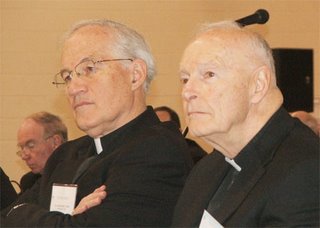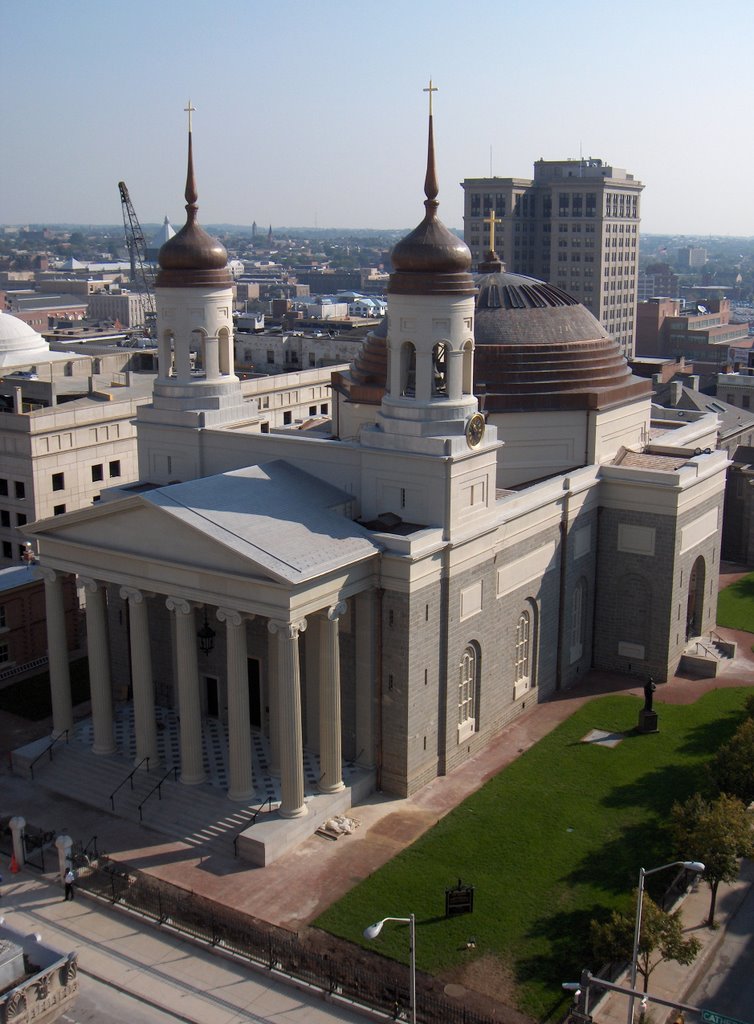Today's edition of
Catholic New York features a
long, detailed message from Cardinal Egan, writing in his standard column, "In the Holiness of Truth."
As this is the cardinal's first public message in recent weeks, and in light of his statement that "All who do not see this publication will know only what those who control the culture want them to know, and truth and decency will pay the price," below is the column's complete, unedited text, with the relevant links of cited documents added for purposes of context.
*******************
AnonymousThis a sad tale, but a tale that needs to be told, fully and accurately.
On Tuesday, Oct. 10th, a "blog" in Philadelphia that specializes in Church gossip published a
letter attacking my pastoral service to the Archdiocese of New York. The letter was unsigned and alleged to be the product of a "committee" of clergy. In point of fact, it may have been written by a member of the clergy, a member of the laity or even a group of clergy and/or laity. Curiously, there are several indications that argue against clerical authorship. It is unlikely, for example, that any of the clergy would be unaware of my pastoral involvement after the tragedy of September 11th, 2001; and one hopes that most priests would know that the word "disinterested," is a positive rather than negative quality. Nothing, however, can be concluded with certainty about the authorship of the letter. It remains a secret, a secret of cowards.
Whatever of this, the press, television and radio had a field day attributing the letter to "key members of the New York clergy," "leaders among New York priests" and such. And tragically, most of the faithful will in all likelihood believe these unsubstantiated attributions of the media. Thus the damage is done.
[TEXTBOX] 'We Stand With Him In Confidence'
Following is the statement issued by the Priests' Council of the Archdiocese of New York on Oct. 16
The Priests' Council of the Archdiocese of New York met for two hours today with His Eminence, Edward Cardinal Egan. As representatives of the clergy of the Archdiocese, we came together to meet with our Archbishop and to discuss with him the letter that has circulated among some of the priests and in the media.
We are appalled that the letter was sent anonymously, and that it can and has been used by those who seek to damage the Church. As today's meeting has shown, it is possible to meet and discuss any issue with Cardinal Egan, and if any priest has a concern he can raise it and discuss it at any time. A letter of this sort does a grave disservice to the entire Church, and to this Archdiocese in particular.
We are also upset and dismayed that our Archbishop has been personally vilified in this manner. At today's meeting, the members of the Priests' Council reiterated their support for His Eminence. We stand with him in confidence, and look forward to his continued ministry to the clergy, religious and laity of the Archdiocese of New York. [/TEXTBOX]
The story received further attention when a New York tabloid reported on October 16th that Msgr. Howard Calkins, vicar for the South Shore of Westchester, had announced that the letter was supported by the majority of priests of the Archdiocese. And to this he added that the principal reason for the support was the unjust treatment that had been and was being inflicted by me on priests who were accused of sexually abusing minors, even though all of the alleged incidents had taken place during the tenures of my predecessors and decisions regarding the priests accused of abuse were the fruit of analysis and discussion by a board of distinguished laity and clergy without any involvement on my part.
As the press, television and radio turned up the heat, the public was made to believe that some sort of "revolution" had developed against the "embattled Cardinal." Photographs of me with a twisted expression on my face were attached to articles about the affair and played off against a portrait of Msgr. Calkins in priestly vestments, kneeling and embracing an African-American girl of six or seven years of age. No one could fail to understand what was happening. It was the kind of thing the Catholic Church has endured for many a generation and will undoubtedly endure for many more.
To further illustrate how vicious the attack had become, it might be interesting to note that one of the television channels reported that I had scheduled a meeting of the Presbyteral Council to discuss the anonymous letter at the same time as the funeral of a popular pastor in Chappaqua because I was "completely out of touch with the Archdiocese." As a matter of fact, the meeting was scheduled and the priests had been invited to attend it before the pastor passed away. Though requested to correct the report, the television channel let the allegation stand.
The aforementioned meeting to discuss the letter and its fallout was held at my residence on October 16th. I had it there because just five weeks earlier I had had a total knee replacement at the Hospital for Special Surgery in Manhattan and my physical therapist felt it unwise for me to attempt to journey back and forth to the seminary in Yonkers where meetings of the Presbyteral Council are regularly held.
The meeting opened with my reading
a letter from the above-mentioned Msgr. Calkins that had been delivered to my residence in the morning. It was a partial correction of the misstatements in the tabloid and a curious protest of loyalty. I made no comment on the letter and believe that the priests were pleased that I did not. The assertions and the attempt to water them down were frankly an embarrassment for us all.
In any case, the letter was given to the newspapers, television channels and radio stations, most of which quoted a few phrases from it and immediately returned to repeating in detail the accusations in the anonymous letter. A signed letter evidently carried less weight with the media than an unsigned one.
After dispensing with Msgr. Calkins' letter, I invited the priests to make whatever observations they wished about the entire episode. This approach came as no surprise to anyone. For at meetings of the Presbyteral Council all freely say whatever is on their mind, just as all did at two overnight convocations of the clergy of the Archdiocese two years ago.
When each had said what he wanted to say, I asked for a break in which I might walk about the residence for several minutes to keep my knee from stiffening up. This done, I spoke at length about the situation under discussion and as well about several other matters that needed to be brought out into the open and clarified. At this time I am considering another set of convocations in which I might be able to repeat to all of the priests of the Archdiocese what I said to the Presbyteral Council.
Having completed my remarks, which occasioned numerous comments and questions from the priests, I went upstairs to do a set of leg exercises that are part of my rehabilitation program. Downstairs, without any urging or participation on my part, the priests put together
a formal declaration that was given immediately to the media. One newspaper on Staten Island printed it, and this I considered quite an achievement. For not even one newspaper anywhere in New York printed the so-called
"letter of apology" from Msgr. Calkins. Indeed, in its evening newscast after the meeting of the Presbyteral Council, one of the television channels ignored the declaration of the Presbyteral Council altogether and spent all of its time on repeating the ugliest accusations from the anonymous letter, all of which it had aired over and again for days.
Happily, Catholic New York makes available in this issue both the
declaration of the Presbyteral Council and
Msgr. Calkins' letter. (Cf. pages 5 and 6). All who do not see this publication will know only what those who control the culture want them to know, and truth and decency will pay the price.
In his statement to the tabloid, Msgr. Calkins indicated that the basis for the anonymous attack on me is the unjust treatment that has allegedly been meted out to priests who have been accused of sexually abusing minors. The anonymous letter suggests the same, and in my judgment both are correct.
When a priest accused of sexually abusing a minor has had his case investigated by the Office for Priest Personnel and heard by the Archdiocesan Advisory Review Board, he is free to tell his friends and all the world whatever he pleases about the case. The Archdiocese, on the other hand, is expected to remain silent out of respect for the priest.
This must not continue. For it leads to accusations against the Archdiocese and its Archbishop which many will believe if the accusations are not challenged; and as a result, immense harm is done. Accordingly, I will be instituting a process whereby the Archdiocese will be in a position to deal appropriately with the situation.
Let us suppose that a priest who has been accused of sexually abusing a minor has had his case investigated and decided according to the established Archdiocesan process. Let us further suppose that he is found to be telling tales about what he has done and what has been done to him. Such a priest will be invited to write me a letter taking back all untruths and proffering a fitting apology. If he refuses, he will be asked to appear before a panel of six priests -- three from the Presbyteral Council and three Vicars -- to make his case. When he is finished, a representative of the Archdiocese will present to the panel what it knows about the matter along with all relevant documentation. It will be up to the panel to report to the Archdiocesan Presbyteral Council as to whether the case has been handled properly. Inasmuch as all cases treated during my tenure have, I believe, been so treated, I am confident about the outcome. This, however, will be determined by the panel.
If the priest refuses to write the letter mentioned above and refuses as well to appear before the panel, a representative of the Archdiocese will make the case of the Archdiocese to the panel, so that an appropriate report can be set before the Presbyteral Council.
All of this I will be asking the priests of the Archdiocese to discuss at their Vicariate meetings in November so that the process can be addressed by the Presbyteral Council at its December meeting. I will then reduce my load of liturgies, meetings, visits, dinners and such during January, February and March so that I might go over the process in depth at 19 Vicariate meetings. If a convocation cannot be arranged in the reasonably near future, I will also use the occasion of the Vicariate meetings to go over with the priests what I said to the Presbyteral Council members on October 16th. With the help of the Lord, the good name of the Church will thus be protected and we will be able to move on to other matters of crucial importance at this time in our history—matters of faith, holiness and service to the Savior and His People.
Edward Cardinal Egan
Archbishop of New York
-30-












